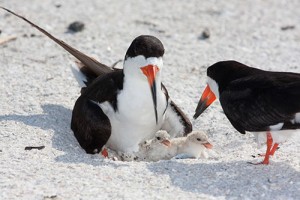
OCEAN CITY — The Maryland Coastal Bays Program this week is asking the boating public to reduce or eliminate wakes around a small, sandy island near the Route 50 Bridge that is the only location for nesting endangered Black Skimmers in the entire state of Maryland.
The small, unnamed island, referred to by many unofficially as OC Spoils, is home to the only known nesting area for endangered Black Skimmers. The island is also home to a few nests for Common Terns, a bird that is also being closely monitored due to diminished habitat. The common tern colony currently nesting on the OC Spoils island is the only viable colony in the entire coastal bays watershed.
Because of the close proximity of the island just west of the Ocean City navigation channel with relatively deep water and no sand shoals to protect it, nest and chick loss to wakes from larger boats traveling above six knots has been an historic and continuing mortality factor for the endangered species.
To that end, the Maryland Coastal Bays program this week is reaching out to the boating public to please keep their vessels at a no wake speed between the red triangle Channel Number 2 marker to the Six Knot marker near the Route 50 bridge. Some of the bird nests are relatively low on the beach where the combination of high tide levels, especially round new and full moons, and large boat wakes are resulting in next and chick losses at an alarming rate.
The nest and chick loss was a significant issue back when the site was used as a nesting area for colonies of Black Skimmers and Common Terns in the mid-90s, but diminished somewhat when the species relocated their nesting areas to other sites. Now that the sandy island near the main channel has been reoccupied again by the endangered species, the MCBP is seeking the public’s help in eliminating at least the man-made threat to the nesting birds.
Nesting Common Terns and Black Skimmers heavily used the island for a decade between the mid-1980s and the mid-1990s. The populations of the species in Maryland were then much higher at around 2,500, or 250 nesting pairs. For the next decade, the two species relocated to other more suitable habitats in the coastal bays. However, increased development and other changes has recently resulted in the loss of those other habitats, forcing the terns and skimmers to return to their traditional nesting site on the sandy island near the main navigational channel.
Common Tern and Black Skimmer populations have decline dramatically in Maryland in the last two decades. Black Skimmers are currently listed as endangered in Maryland, while Common Terns are currently proposed for a change in status to endangered as soon as the necessary regulatory process is completed. Both Black Skimmers and Common Terns prefer to next on relatively open sandy beaches.
In the coastal bays watershed, there were only two breeding colonies of Black Terns located during extensive surveys in mid-June and they contained a total of only 10 breeding pairs. A revisit to both colony sites last week found that the larger colony had totally abandoned its breeding attempt and the only remaining active colony in the coastal bays consisted of only four breeding pairs located on the small island adjacent to the navigation channel.
To that end, the MCBP is urging boaters utilizing the channel, particularly during the sensitive nesting periods for the endangered birds, to reduce speeds in the area of the navigation channel closest to the sandy island and create no wakes in order to protect the important species.

